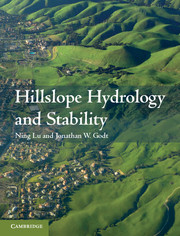Book contents
- Frontmatter
- Contents
- Foreword
- Preface
- List of Symbols
- PART I Introduction and state of the art
- PART II Hillslope hydrology
- Part III Total and effective stress in Hillslopes
- PART IV Hillslope Material properties
- 7 Strength of hillslope materials
- 8 Hydro-mechanical properties
- PART V Hillslope stability
- References
- Index
- Plate section
8 - Hydro-mechanical properties
from PART IV - Hillslope Material properties
Published online by Cambridge University Press: 05 February 2013
- Frontmatter
- Contents
- Foreword
- Preface
- List of Symbols
- PART I Introduction and state of the art
- PART II Hillslope hydrology
- Part III Total and effective stress in Hillslopes
- PART IV Hillslope Material properties
- 7 Strength of hillslope materials
- 8 Hydro-mechanical properties
- PART V Hillslope stability
- References
- Index
- Plate section
Summary
Methods for measurement of suction
Determination of the hydraulic and mechanical properties of unsaturated soil, such as the soil water retention curve (SWRC), hydraulic conductivity function (HCF), and suction stress characteristic curve (SSCC) is critical and necessary for analyzing fluid flow and mechanical behavior of unsaturated soils in hillslope environments. Many methods have been developed for measuring unsaturated hydraulic properties using both experimental and theoretical approaches. The common experimental methods for SWRC measurement are (1) axis translation techniques (Tempe cells, pressure plate apparatus, modified triaxial cells (ASTM D6836)), (2) varieties of tensiometers, (3) psychrometers, (4) filter paper, (5) hygrometer, and (6) humidity chamber (e.g., Hilf, 1956; Spanner, 1951; Gee et al., 1992; Houston et al., 1994; Likos and Lu, 2003). Concurrent control and measurement of water content and suction are typically performed using the aforementioned suction techniques and water content measurement techniques such as (1) measurement of inflow and outflow of fluid volume or weight, (2) time-domain reflectometry (TDR probes), and (3) dielectric moisture probes (ECHO-probes). The approximate measurement ranges for various suction or SWRC measurements are shown in Figure 8.1.
In general, existing laboratory techniques for suction measurement and control are complex and time-consuming to use, and limited in the range of suction or water content that can be measured, as shown in Figure 8.1. In addition, most experimental methods, such as Tempe cells and pressure plates, are best suited for determining the SWRC under drying conditions (see the review by Bocking and Fredlund (1980)). However, wetting conditions better describe infiltration and flow in hillslopes shortly following rainfall. Because of the hysteretic behavior typical of many soils, suction values at the same water content but with different wetting or drying histories could be very different, as described in this section. By way of introduction, the aforementioned five methods for measuring or controlling suction are briefly described below.
- Type
- Chapter
- Information
- Hillslope Hydrology and Stability , pp. 282 - 310Publisher: Cambridge University PressPrint publication year: 2013



